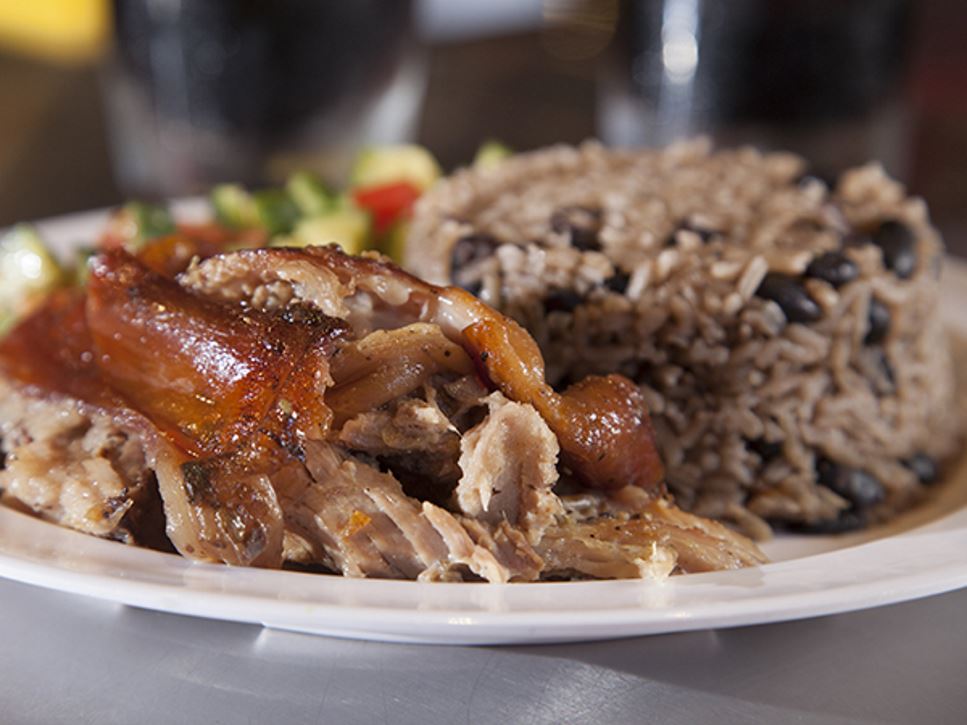What Puerto Rico lacks in size, it makes up for in its wonderful cuisine. Nestled between the Caribbean Sea and the Atlantic Ocean, this little island packs a punch when it comes to food. The local cuisine is a blend of Spanish, African and taíno Indian influences. When you ask a local what their favorite dish is, they will usually answer rice and beans with roasted chicken and a slice of avocado; or bacalao con viandas, which is marinated dried, salted cod fish with root vegetables; or mofongo, which is fried and mashed plantain.
Puerto Rican cuisine includes fiber-packed beans, fresh fish, tropical fruits and flavorful herbs and spices. As with any cuisine, cooking methods and portion sizes can make a difference in your eating routine. Read on to learn more about Puerto Rican specialties. Plus, we've included tips you can use to make them healthier for you and your family.
Arroz con Habichuelas
Rice and beans, or arroz con habichuelas, is a staple dish. Packed with fiber, vitamins and minerals, arroz con habichuelas often is cooked with salt and oil. Make a healthier version by reducing the amount of salt and oil or substituting brown rice. Arroz con habichuelas usually comes with stewed or fried fish, fried or roasted pork or chicken. Choosing foods that are stewed, baked, grilled or roasted instead of fried or deep-fried is another way to make this meal healthier.
Fish, Meat and Pork
Like many cultures, in Puerto Rico, food is a main attraction during social events, family reunions or outings. Frituras or cuchifritos are the name given to a variety of fried foods usually served in local restaurants as appetizers or during festivals and street fairs. These include fried pork rinds, cod fritters, cheese balls, fried meat or fish turnovers and alcapurrias, which are made of green bananas and taro root and stuffed with meat or crab and fish. Limiting yourself to small portions on special occasions is an example of how these types of foods can still be enjoyed throughout the year.
Plantains and Bananas
Plantains and green bananas are ubiquitous in Puerto Rican cooking and are good sources of several vitamins and minerals, including vitamin B6, magnesium, potassium and copper. They’re also excellent sources of vitamins C and K. You cannot eat these starchy bananas raw. Many traditional dishes call for frying them. Tostones are twice-fried plantains and a popular side dish served with fried, whole fish or stews and soups. Mofongo consists of plantains that are fried and mashed with some oil, garlic, salt and pork rinds. Healthier options include eating boiled green bananas or using an air fryer to prepare tostones.
Vegetables and Tropical Fruits
Puerto Rican cuisine features a number of locally grown fruits and vegetables. When planning your meals, include a variety of vegetables, such as okra or kimbombó, tomatoes, onions, chayote squash, watercress, eggplant and peppers. Satisfy your sweet tooth with mango, papaya, pineapple, guava, passion fruit, oranges and tamarind. Eating these foods while in season ensures the best flavor and nutritional value.
Seasonings
Puerto Rican food is highly seasoned, but not spicy. Common herbs and spices include oregano, bay leaves, garlic, parsley, cilantro, culantro, basil and Caribbean thyme. With so many flavors, the meals can be delicious without adding salt. Sofrito, a savory mixture of onions, garlic, peppers and cilantro, is key to making Puerto Rican food unique. Puerto Rican cooks use it as a base in many dishes including beans, soups, stews, chicken and meats.
To prepare your favorite Puerto Rican dishes at home, focus on some of the healthiest ingredients: beans, fresh-caught fish, vegetables, fruits and herbs. It's OK to indulge in fried foods and appetizers every now and then. Watch your portions and fill most of your plate with vegetables and fruit. The rest of your plate can include a lean protein food and grains, especially whole grains, along with a serving from the dairy food group. Refer to MyPlate, or MiPlato, as a guide.
Find a Nutrition Expert
Looking for credible nutrition information and recommendations? The Academy of Nutrition and Dietetics' network of credentialed food and nutrition practitioners are ready to help!

